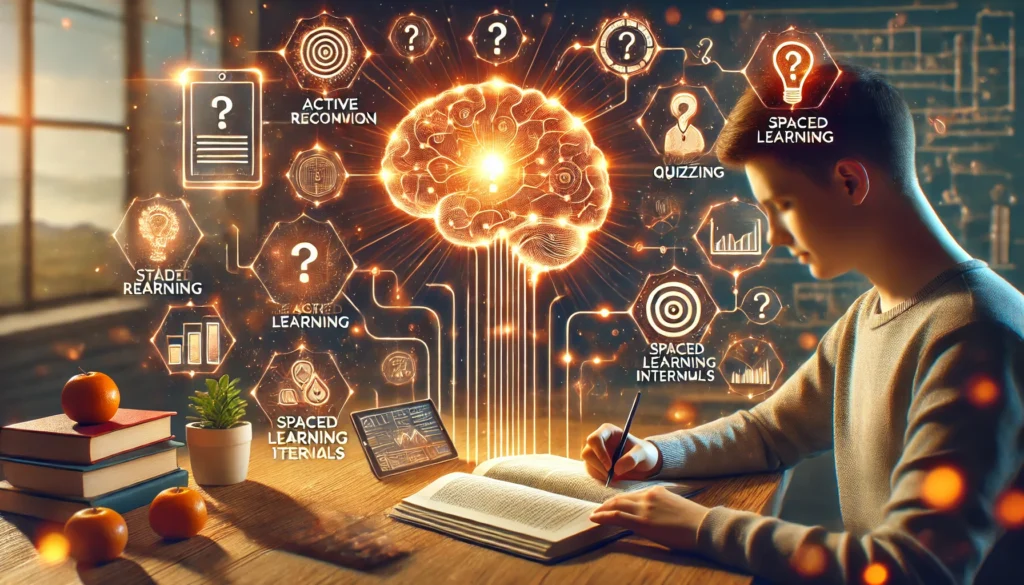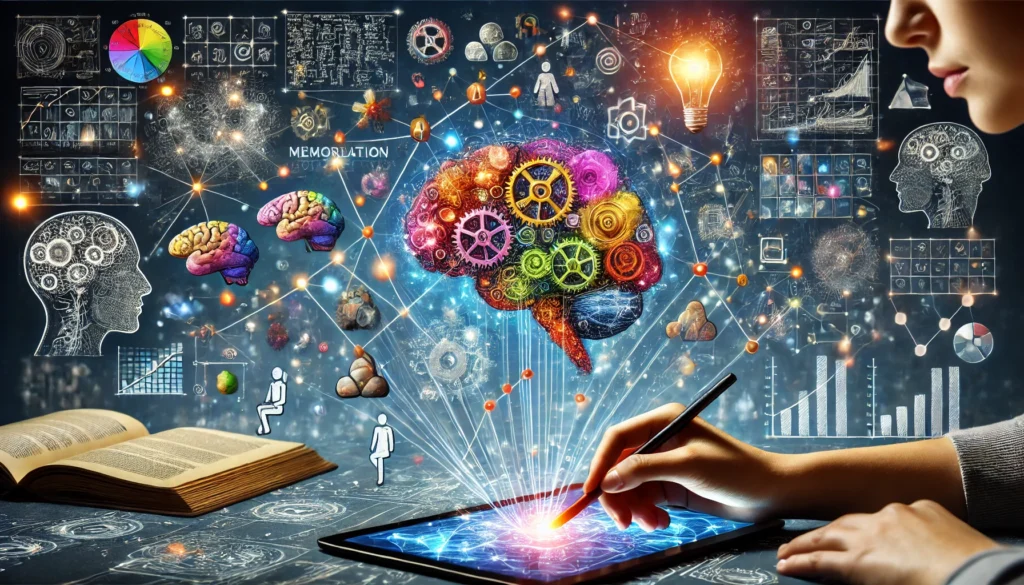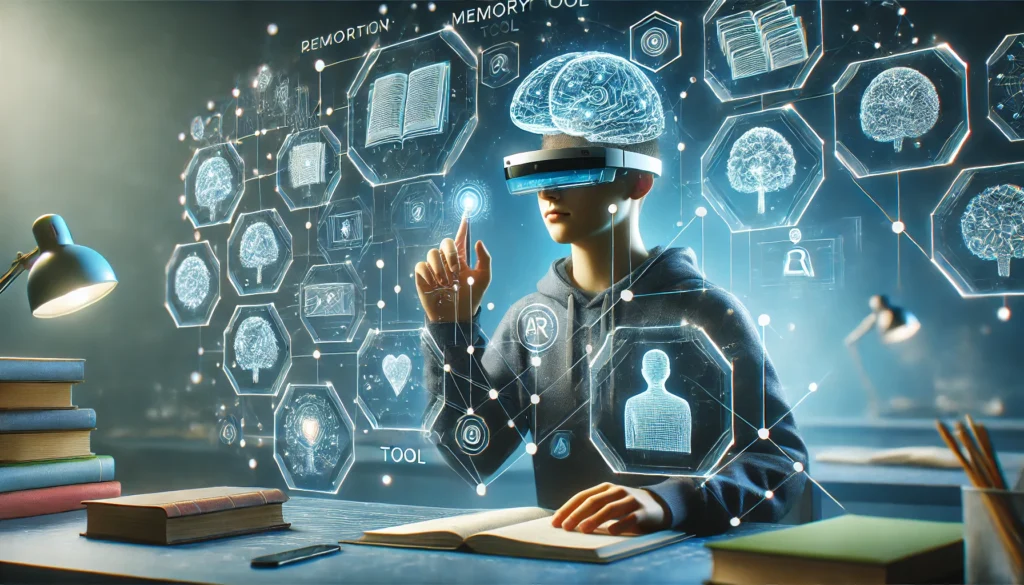Before exploring specific tools, it is crucial to understand the cognitive processes involved in memorization. At its core, memorization involves encoding, storage, and retrieval. Encoding refers to the initial perception and processing of information. Storage is the retention of encoded information over time, while retrieval involves accessing stored information when needed.
You may also like: Memory Techniques for Better Studying
The Science Behind Memorization
Cognitive psychology and neuroscience have shed light on the mechanisms that facilitate effective memorization. Techniques such as spaced repetition and active recall are grounded in scientific principles and have been shown to enhance memory retention. Spaced repetition involves reviewing information at gradually increasing intervals, optimizing the encoding and storage phases. Active recall, on the other hand, emphasizes the retrieval process by encouraging self-testing and quizzing.
Spaced Repetition
Spaced repetition is built on the understanding of the forgetting curve, which illustrates how information is lost over time when not reviewed. By scheduling reviews at strategic intervals, spaced repetition helps reinforce information just as it’s about to be forgotten, thereby strengthening memory retention. This approach has been successfully implemented in various educational apps and platforms, making it accessible for students worldwide.
Active Recall Techniques
Active recall leverages the brain’s natural ability to retrieve information, strengthening neural connections each time a piece of information is recalled. Techniques like self-quizzing, flashcards, and even teaching the material to someone else can significantly improve retention. This method not only aids memorization but also enhances understanding, as it forces students to actively engage with the material rather than passively reviewing notes.
The Role of Cognitive Load
Understanding the cognitive load is essential in memorization. Cognitive load refers to the amount of working memory used when learning new information. By managing cognitive load effectively, students can avoid overload and enhance their learning efficiency. Techniques that distribute the cognitive load, such as breaking information into smaller segments, can help optimize learning.
Traditional Memorization Techniques
Though digital tools have gained popularity, traditional memorization techniques remain relevant. These methods have stood the test of time and continue to provide a solid foundation for effective learning.
Mnemonics
Mnemonics are memory aids that simplify complex information through the use of acronyms, rhymes, or visual associations. By linking new information to familiar concepts, mnemonics facilitate easier recall.
Acronyms and Acrostics
Acronyms and acrostics are popular mnemonic devices that use the first letters of a series of words to form a new word or phrase. This method helps students remember sequences or lists, such as “PEMDAS” for the order of operations in math. Acrostics, like “Every Good Boy Deserves Fudge” for music notes, create memorable phrases that aid recall.
Rhymes and Jingles
Rhymes and jingles use the musicality of language to enhance memorization. The rhythm and melody of a rhyme make the information more engaging and easier to remember. This technique is often used in education for young children to help them learn foundational concepts like the alphabet or basic math facts.
Visualization in Mnemonics
Visualization is a powerful aspect of mnemonics that involves creating vivid mental images to represent information. By associating abstract ideas with concrete images, students can improve recall. For instance, visualizing the structure of a cell as a factory with different departments can help students remember cell functions.

Mind Mapping
Mind mapping is a visual technique that organizes information hierarchically. It allows students to create a visual representation of concepts and their interconnections, facilitating a deeper understanding of the material.
Creating Effective Mind Maps
The effectiveness of a mind map lies in its organization and clarity. To create an effective mind map, students should start with a central concept and branch out into subtopics. Using different colors, shapes, and images can further enhance the map’s visual appeal and aid memory retention.
Benefits of Mind Mapping
Mind mapping engages both hemispheres of the brain, promoting creativity and analytical thinking. This dual engagement enhances comprehension and retention, making mind maps particularly useful for subjects that require understanding complex relationships, like history or science.
Mind Mapping Tools
While traditional pen-and-paper mind maps are effective, digital tools like MindMeister or XMind offer additional functionalities. These tools allow for easy editing, sharing, and integration with other digital resources, making them versatile options for modern learners.
Digital Memorization Tools
In the digital age, a plethora of online tools and applications have emerged to assist students in their memorization endeavors. These tools leverage technology to enhance cognitive processes and streamline learning.
Flashcard Apps
Flashcards have long been a staple of memorization, and digital flashcard apps have elevated this technique to new heights. Apps such as Anki and Quizlet utilize spaced repetition algorithms, ensuring that information is reviewed at optimal intervals.
Advanced Features of Flashcard Apps
Modern flashcard apps offer features beyond simple question-and-answer formats. They include multimedia elements like audio, images, and videos to cater to different learning styles. Additionally, collaborative features allow students to share decks and study in groups, fostering a sense of community and collaborative learning.
Customizing Flashcards for Individual Needs
One of the greatest advantages of digital flashcard apps is the ability to customize decks. Students can tailor their flashcards to focus on areas they find challenging, ensuring a personalized learning experience. This customization can also help in targeting specific academic goals or preparing for exams.
Accessibility and Convenience
The portability of digital flashcards makes them accessible anytime, anywhere. This convenience allows students to make the most of their downtime, whether it’s during a commute or between classes, thus integrating study sessions seamlessly into their daily routines.
Memorization Websites
Several websites are dedicated to aiding memorization through interactive exercises and quizzes. Websites like Memrise and Khan Academy offer a wide range of subjects and topics, allowing students to tailor their learning experience to their specific needs.
Interactive Learning Modules
These websites often feature interactive modules that engage students through gamified learning experiences. By turning learning into a game, students are more likely to stay motivated and retain information. Features such as leaderboards and achievements add a competitive edge, encouraging consistent study habits.
Diverse Subject Matter
Websites like Khan Academy cover a broad spectrum of subjects, providing resources for everything from math and science to humanities and arts. This diversity allows students to explore different areas of interest and develop a well-rounded knowledge base.
Community and Support
Many educational websites offer forums and discussion boards where students can ask questions, share insights, and support each other. This sense of community can alleviate the isolation often felt during self-study, providing encouragement and diverse perspectives.
Innovative Memorization Strategies
Visualization Techniques
Visualization is a powerful cognitive tool that enhances memory retention by creating vivid mental images. Students can employ visualization techniques by associating abstract concepts with concrete imagery.
Creating Mental Simulations
Mental simulations involve imagining detailed scenarios that incorporate the information being learned. For example, visualizing a scientific process or historical event as a movie scene can make abstract concepts more tangible and memorable.
Sensory Engagement
Engaging multiple senses through visualization can strengthen memory retention. By imagining sounds, smells, and tactile sensations associated with a concept, students create richer and more robust memory traces, enhancing recall.

Storytelling as a Visualization Tool
Turning information into a story can be an effective visualization strategy. By creating narratives around facts or concepts, students can make the material more relatable and easier to remember. This approach is particularly useful in subjects like history or literature.
Chunking
Chunking involves breaking down complex information into smaller, manageable chunks. This technique aligns with the brain’s natural tendency to process information in segments.
Understanding the Chunking Process
The chunking process involves grouping related information together, making it easier for the brain to process and retain. This technique can be applied to various types of information, from numbers and vocabulary to concepts and procedures.
Chunking in Practice
For instance, when memorizing a long sequence of numbers, students can group them into smaller sets, such as phone numbers or dates. In language learning, vocabulary can be chunked into thematic groups, enhancing recall by associating words with common contexts.
Benefits of Chunking
Chunking reduces cognitive load, allowing the brain to focus on understanding rather than memorizing. By organizing information into familiar patterns, students can improve retention and comprehension, making learning more efficient and effective.
Future Implications of Memorization Tools
The landscape of education continues to evolve, driven by advancements in technology and cognitive science. As these fields progress, the potential for even more effective memorization tools becomes apparent.
Virtual Reality (VR) and Augmented Reality (AR)
VR and AR technologies hold immense promise for transforming memorization. By immersing students in simulated environments, these technologies provide experiential learning opportunities that enhance memory retention.
Experiential Learning through VR
Imagine studying ancient civilizations by virtually exploring historical sites or interacting with 3D models of biological structures. Such immersive experiences can significantly boost comprehension and recall, making learning more interactive and engaging.
AR in Everyday Learning
AR can overlay digital information onto the physical world, providing contextual learning opportunities. For instance, AR apps can enhance biology lessons by projecting 3D models of organs onto a student’s environment, allowing for hands-on exploration.
Overcoming Learning Barriers
VR and AR can help overcome traditional learning barriers, such as geographical limitations or resource availability. By providing virtual access to museums, laboratories, and historical sites, students can gain a broader understanding of their subjects.
Artificial Intelligence (AI) in Education
AI has the potential to revolutionize education by personalizing learning experiences. AI algorithms can analyze individual learning patterns and adapt content delivery accordingly.
Personalized Learning Paths
By tailoring memorization exercises to each student’s unique needs, AI can optimize the encoding, storage, and retrieval processes, maximizing learning outcomes. This personalization ensures that students receive the right level of challenge and support, enhancing their academic performance.
Predictive Analytics in Education
AI can also predict learning outcomes and identify areas where students may struggle. By providing timely interventions and resources, AI helps educators address learning gaps before they become significant obstacles.
AI-Powered Study Assistants
AI-powered study assistants can provide on-demand support, answering questions, suggesting resources, and even generating practice quizzes. These virtual tutors can help students stay on track and maintain motivation throughout their learning journey.

Conclusion
In the quest for academic excellence, effective memorization tools play a pivotal role in enhancing students’ learning experiences. From traditional techniques like mnemonics and mind mapping to cutting-edge digital tools and innovative strategies, the options are vast and varied. By leveraging these tools, students can optimize their study habits, improve retention, and achieve academic success. As the field of education continues to evolve, the future holds exciting possibilities for even more advanced memorization tools, promising a brighter and more efficient learning journey for students worldwide.
Further Reading:
Memorization tool bulks up brain’s internal connections, scientists say
Important Note: The information contained in this article is for general informational purposes only, and should not be construed as health or medical advice, nor is it intended to diagnose, prevent, treat, or cure any disease or health condition. Before embarking on any diet, fitness regimen, or program of nutritional supplementation, it is advisable to consult your healthcare professional in order to determine its safety and probable efficacy in terms of your individual state of health.
Regarding Nutritional Supplements Or Other Non-Prescription Health Products: If any nutritional supplements or other non-prescription health products are mentioned in the foregoing article, any claims or statements made about them have not been evaluated by the U.S. Food and Drug Administration, and such nutritional supplements or other health products are not intended to diagnose, treat, cure, or prevent any disease.


